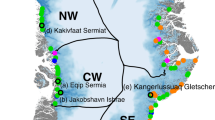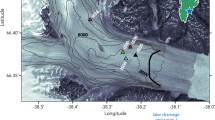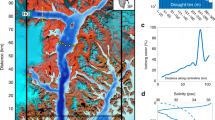Abstract
In the coming decades, significant changes in the polar regions will increase the contribution of ice sheets to global sea-level rise. Under the ice streams and outlet glaciers that deliver ice to the oceans, water and deformable wet sediments lubricate the base, facilitating fast ice flow. The influence of subglacial water on fast ice flow depends on the geometry and capacity of the subglacial hydrologic system: water moving rapidly through a well-connected system of conduits or channels will have little impact on ice-sheet velocities, but water injected into a spatially dispersed subglacial system may reduce the effective pressure at the base of the ice sheet, and thereby trigger increased ice-sheet velocities. In Greenland, the form of the subglacial hydrologic system encountered by increasing surface melt water will determine the influence of changing atmospheric conditions on ice-sheet mass balance. In Antarctica, subglacial lakes have the capacity to both modulate velocities in ice streams and outlet glaciers and provide nucleation points for new fast ice-flow tributaries. Climate models of ice-sheet responses to global change remain incomplete without a parameterization of subglacial hydrodynamics and ice dynamics.
This is a preview of subscription content, access via your institution
Access options
Subscribe to this journal
Receive 12 print issues and online access
$259.00 per year
only $21.58 per issue
Buy this article
- Purchase on Springer Link
- Instant access to full article PDF
Prices may be subject to local taxes which are calculated during checkout


Similar content being viewed by others
References
Cruikshank, J. Do glaciers listen?: Local Knowledge, Colonial Encounters, and Social Imagination (UBC Press, Seattle, University of Washington Press, Vancouver, 2005).
Small, C. & Cohen, J. E. Continual physiography, climate and the global distribution of human population. Curr. Anthropol. 45, 269–277 (2004).
Cabanes, C., Cazenave, A. & Le Provost, C. Sea level rise during past 40 years determined from satellite and in situ observations. Science 294, 840–842 (2001).
Cazenave, A. How fast are the ice sheets melting? Science 314, 1250–1252 (2006).
Meier, M. F. et al. Glaciers dominate eustatic sea-level rise in the 21st century. Science 317, 1064–1067 (2007).
Rignot, E. & Kanagaratnam, P. Changes in the velocity structure of the Greenland ice sheet. Science 311, 986–990 (2006).
Rignot, E. et al. Recent Antarctic ice mass loss from radar interferometry and regional climate modelling. Nature Geosci. 1, 106–110 (2008).
Lemke, P. et al. in Climate Change 2007: The Physical Science Basis. Contribution of Working Group I to the Fourth Assessment Report of the Intergovernmental Panel on Climate Change (eds Solomon, S. et al.) 337–383 (Cambridge Univ. Press, Cambridge, UK and New York, USA, 2007).
Bamber, J. L., Layberry, R. L. & Gogineni, S. A new ice thickness and bed data set for the Greenland ice sheet. 1. Measurement, data reduction, and errors. J. Geophys. Res. —Atmos. 106, 33773–33780 (2001).
Eldrett, J. S. et al. Continental ice in Greenland during the Eocene and Oligocene. Nature 446, 176–179 (2007).
Shackleton, N. J. et al. Oxygen isotope calibration of the onset of ice-rafting and history of glaciation in the North Atlantic region. Nature 307, 620–623 (1984).
Cuffey, K. M. & Marshall, S. J. Substantial contribution to sea-level rise during the last interglacial from the Greenland ice sheet. Nature 404, 591–594 (2000).
Willerslev, E. et al. Ancient biomolecules from deep ice cores reveal a forested southern Greenland. Science 317, 111–114 (2007).
Lythe, M. B. & Vaughan, D. G. BEDMAP: A new ice thickness and subglacial topographic model of Antarctica. J. Geophys. Res.— Sol. Ea. 106, 11335–11351 (2001).
Flower, B. P. Middle Miocene deep-water paleoceanography in the Southwest Pacific — Relations with East Antarctic ice-sheet development. Paleoceanography 10, 1095–1112 (1995).
Scherer, R. P. et al. Pleistocene collapse of the West Antarctic Ice Sheet. Science 281, 82–85 (1998).
Alley, R. B. & Bindshadler, R. A. The West Antarctic Ice Sheet and sea level change. Antarctic Research Series 77, 1–11 (2001).
DeConto, R. M. & Pollard, D. Rapid Cenozoic glaciation of Antarctica induced by declining atmospheric CO2. Nature 421, 245–249 (2003).
Flower, B. P. & Kennett, J. P. Middle Miocene ocean-climate transition — High-resolution oxygen and carbon isotopic records from Deep-Sea Drilling Project Site 588a, southwest Pacific. Paleoceanography 8, 811–843 (1993).
Joughin, I., Abdalati, W. & Fahnestock, M. Large fluctuations in speed on Greenland's Jakobshavn Isbrae glacier. Nature 432, 608–610 (2004).
Krabill, W. et al. Greenland Ice Sheet: Increased coastal thinning. Geophys. Res. Lett. 31, 10.1029/2004GL021533 (2004).
Zwally, H. J. et al. Mass changes of the Greenland and Antarctic ice sheets and shelves and contributions to sea-level rise: 1992–2002. J. Glaciol. 51, 509–527 (2005).
Thomas, R., Frederick, E., Krabill, W., Manizade, S. & Martin C. Progressive increase in ice loss from Greenland. Geophys. Res. Lett. 33, 10.1029/2006GL026075 (2006).
Johannessen, O. Recent ice-sheet growth in the interior of Greenland. Science 310, 5750 (2005).
Luthcke, S. B. et al. Recent Greenland ice mass loss by drainage system from satellite gravity observations. Science 314, 1286–1289 (2006).
Davis, C. H. et al. Snowfall-driven growth in East Antarctic ice sheet mitigates recent sea-level rise. Science 308 (5730), 1898–1901 (2005).
Wingham, D. J., Shepherd, A., Muir, A. & Marshall, G. J. Mass balance of the Antarctic ice sheet. Evolution of the Antarctic ice sheet; new understanding and challenges. Phil. Trans. R. Soc. 364, 1627–1635 (2006).
Velicogna, I. & Wahr, J. Measurements of time-variable gravity show mass loss in Antarctica. Science 311, 1754–1756 (2006).
Chen, J. L., Wilson, C. R., Blankenship, D. D. & Tapley, B. D. Antarctic mass rates from GRACE. Geophys. Res. Lett. 33, 10.1029/2006GL026369 (2006).
Rignot, E. Changes in ice dynamics and mass balance of the Antarctic ice sheet. Phil. Trans. R. Soc. A 364, 1637–1655 (2006).
Alley, R. B. Deformation of till beneath ice stream B, West Antarctica. Nature 322, 57–59 (1986).
Blankenship, D. D. Seismic measurements reveal a saturated porous layer beneath an active Antarctic ice stream. Nature 322, 54–57 (1986).
Clarke, G. K. C. Subglacial processes. Annu. Rev. Earth Planet. Sci. 33, 247–276 (2005).
Kamb, B. Basal zone of the West Antarctic ice streams and its role in lubrication of their rapid motion in the West Antarctic Ice Sheet. Antarctic Research Series 77, 157–199 (2001).
Robin, G. d. Q. Ice movement and temperature distribution in glaciers and ice sheets. J. Glaciol. 2, 523–532 (1955).
Gow, A. J., Ueda, H. T. & Garfield, D. E. Antarctic Ice Sheet — Preliminary results of first core hole to bedrock. Science 161, 1011–1013 (1968).
Flowers, G. E. & Clarke, G. K. C. A multi-component coupled model of glacier hydrology: 1. Theory and synthetic examples. J. Geophys. Res. 107, 10.1029/2001JB001122 (2002).
Steffen, K., Nghiem, S. V., Huff, R. & Neumann, G. The melt anomaly of 2002 on the Greenland Ice Sheet from active and passive microwave satellite observations. Geophys. Res. Lett. 31, 10.1029/2004GL020444 (2004).
Zwally, H. J. et al. Surface melt-induced acceleration of Greenland ice-sheet flow. Science 297, 218–222 (2002).
Abdalati, W. & Steffen, K., Greenland ice sheet melt extent: 1979–1999. J. Geophys. Res. — Atmos. 106, 33983–33988 (2001).
Tedesco, M., Abdalati, W. & Zwally, H. J. Persistent surface snowmelt over Antarctica (1987–2006) from 19.35 GHz brightness temperatures. Geophys. Res. Lett. 34, 10.1029/2007GL031199 (2007).
Paterson, W. S. B. The Physics of Glaciers 3rd edn (Pergamon, Oxford, UK, Tarrytown, New York, 1994).
Fahnestock, M. et al. High geothermal heat flow basal melt, and the origin of rapid ice flow in central Greenland. Science 294, 2338–2342 (2001).
Fountain, A. G. & Walder, J. S. Water flow through temperate glaciers. Rev. Geophys. 36, 299–328 (1998).
Rothlisberger, H. Water pressure in intra- and subglacial channels. J. Glaciol. 11, 117–203 (1972).
Nye, J. F. Water flow in glaciers: jokulhlaups, tunnels and veins. J. Glaciol. 17, 181–207 (1976).
Weertman, J. On the sliding of glaciers. J. Glaciol. 3, 33–38 (1957).
Lliboutry, L. Contribution à la théorie du frottement des glaciers sur leur lit. C. R. Séances Acad. Sci. 247D, 318–320 (1958).
Kamb, B. Glacial surge mechanism 1982–1983 surge of variegated glacier, Alaska. Science 227, 269–279 (1985).
Kamb, B., Glacier surge mechanism based on linked cavity configuration of the basal water conduit system. J. Geophys. Res. 92, 9083–9100 (1987).
Kamb, B. et al. Mechanical and hydrologic basis for the rapid motion of a large tidewater glacier. 2. Interpretation. J. Geophys. Res. — Sol. Ea. 99, 15231–15244 (1994).
Iverson, N. R., Hanson, B., Hooke, R. L. & Jannson, P. Flow mechanism of glaciers on soft beds. Science 267, 80–81 (1995).
Siegert, M. J. et al. A revised inventory of Antarctic subglacial lakes. Antarctic Science 17, 453–460 (2005).
Vaughan, D. G. A. et al. Topographic and hydrological controls on Subglacial Lake Ellsworth, West Antarctica. Geophys. Res. Lett. 34, 10.1029/2007GL030769 (2007).
Bell, R. E. et al. Large subglacial lakes in East Antarctica at the onset of fast-flowing ice streams. Nature. 445, 904–907 (2007).
Fricker, H. A., Scambos, T., Bindschadler, R. & Padman, L. An active subglacial water system in West Antarctica mapped from space. Science 315, 1544–1548 (2007).
Smith, B. E., Joughin, I. R., Fricker, H. A. & Tulaczyk, S. Subglacial water transport throughout Antarctica from ICESAT laser altimetry. Eos Trans. AGU 88 (Fall Meet. Suppl.), abstract C53A-08 (2007).
Bell, R. E., Studinger, M., Fahnestock, M. A. & Shuman, C. A. Tectonically controlled subglacial lakes on the flanks of the Gamburtsev Subglacial Mountains, East Antarctica. Geophys. Res. Lett. 33, 10.1029/2005GL025207 (2006).
Bjornsson, H., Hydrological characteristics of the drainage system beneath a surging glacier. Nature 395, 771–774 (1998).
Flowers, G. E., Bjornsson, H., Palsson, F. & Clarke, G. K. C. A coupled sheet-conduit mechanism for jokulhlaup propagation. Geophys. Res. Lett. 31, 10.1029/2003GL019088 (2004).
Bartholomaus, T. C., Anderson, R. S. & Anderson, S. P. Response of glacier basal motion to transient water storage. Nature Geosci. 1, 33–37 (2007).
Jouzel, J. More than 200 meters of lake ice above subglacial Lake Vostok. Science 286, 2138–2141 (1999).
Bell, R. E., Origin and fate of Lake Vostok water refrozen to the base of the East Antarctic ice sheet. Nature 416, 307–310 (2002).
Joughin, I. et al. Seasonal speedup along the Western Flank of the Greenland Ice Sheet. Science (in the press).
Price, S. F., Payne, A. J., Catania, G. A. & Neumann, T. A. Seasonal acceleration of inland ice via longitudinal coupling to marginal ice. J. Glaciol. (in the press).
Joughin, I., Tulaczyk, S., Fahnestock, M. & Kwok, R. A mini-surge on the Ryder Glacier, Greenland, observed by satellite radar interferometry. Science 274, 228–230 (1996).
Das, S. B. et al. Fracture propagation to the base of the Greenland Ice Sheet during supraglacial lake drainage. Science (in the press).
Peters, L. E., Anandakrishnan, S., Alley, R. B. & Smith, A. M. Extensive storage of basal meltwater in the onset region of a major West Antarctic ice stream. Geology 35, 251–254 (2007).
Gray, L. et al. Evidence for subglacial water transport in the West Antarctic Ice Sheet through three-dimensional satellite radar interferometry. Geophys. Res. Lett. 32, 10.1029/2004GL021387 (2005).
Stearns, L. A. & Hamilton, G. S. Thinning and acceleration of East Antarctic outlet glaciers. Eos Trans. AGU 88 (Fall Meet. Suppl.), abstract C41C-08 (2007).
Wingham, D. J., Siegert, M. J., Shepherd, A. & Muir, A. S. Rapid discharge connects Antarctic subglacial lakes. Nature 440, 1033–1036 (2006).
Lewis, A. R. et al. The age and origin of the Labyrinth, western Dry Valleys, Antarctica: Evidence for extensive middle Miocene subglacial floods and freshwater discharge to the Southern Ocean. Geology 34, 513–516 (2006).
Denton, G. E. & Sugden, D. E. Meltwater features that suggest Miocene ice-sheet overriding of the Transantarctic Mountains in Victoria Land, Antarctica. Geogr. Ann. A 87, 67–85 (2005).
Lowe, A. L. & Anderson, J. B. Evidence for abundant subglacial meltwater beneath the paleo-ice sheet in Pine Island Bay, Antarctica. J. Glaciol. 49, 125–138 (2003).
Goodwin, I. D. The nature and origin of a Jokulhlaup near Casey-Station, Antarctica. J. Glaciol. 34, 95–101 (1988).
Leventer, A. et al. Marine sediment record from the East Antarctic margin reveals dynamics of ice sheet recession. GSA Today 16 (12), 4–10 (2006).
Sawagaki, T. & Hirakawa, K. Erosion of bedrock by subglacial meltwater, Soya Coast, East Antarctica. Geogr. Ann. A 79, 223–238 (1997).
Anderson, J. B. & Fretwell, L. O. Geomorphology of the onset of a paleo-ice stream, Marguerite Bay, Antarctic Peninsula. Earth Surf. Processes 33, 503–512 (2008).
Siegert, M. J. & Bamber, J. L. Subglacial water at the heads of Antarctic ice stream tributaries. J. Glaciol. 46, 702–703 (2000).
Kohler, J. Lubricating lakes. Nature 445, 830–831 (2007).
Alley, R. B., Dupont, T. K., Parizek, B. R. & Anandakrishnan, S. Access of surface meltwater to beds of sub-freezing glaciers: preliminary insights. Ann. Glaciol. 40, 8–14 (2005).
Conway, H. et al. Switch of flow direction in an Antarctic ice stream. Nature 419, 465–467 (2002).
Ng, F. & Conway, H. Fast-flow signature in the stagnated Kamb Ice Stream, West Antarctica. Geology 32, 481–484 (2004).
Joughin, I., Tulaczyk, S., Bindschadler, R. & Price, S. F. Changes in west Antarctic ice stream velocities: Observation and analysis. J. Geophys. Res. — Sol. Ea. 107, 10.1029/2001JB001029 (2002).
Retzlaff, R. & Bentley, C. R. Timing of stagnation of ice stream C, West Antarctica from short-pulse-radar studies of buried surface crevasses. J. Glaciol. 39, 533–561 (1993).
Anandakrishnan, S. & Alley, R. B. Stagnation of ice stream C, West Antarctica by water piracy. Geophys. Res. Lett. 24, 265–268 (1997).
Price, S. F., Bindschadler, R. A., Hulbe, C. L. & Joughin, I. R. Post-stagnation behavior in the upstream regions of Ice Stream C, West Antarctica. J. Glaciol. 47, 283–294 (2001).
MacAyeal, D. R. et al. An Ice-Shelf Model Test Based on the Ross Ice Shelf. Ann. Glaciol. 23, 46–51 (1996).
Scambos, T. A., Bohlander, J. A., Shuman, C. A. & Skvarca, P. Glacier acceleration and thinning after ice shelf collapse in the Larsen B embayment, Antarctica. Geophys. Res. Lett. 31, 10.1029/2004GL020670 (2004).
Rignot, E. et al. Accelerated ice discharge from the Antarctic Peninsula following the collapse of Larsen B ice shelf. Geophys. Res. Lett. 31, 10.1029/2004GL020697 (2004).
Anandakrishnan, S., Catania, G. A., Alley, R. B. & Horgan, H. J. Discovery of till deposition at the grounding line of Whillans Ice Stream. Science 315, 1835–1838 (2007).
Alley, R. B. et al. Effect of sedimentation on ice-sheet grounding-line stability. Science 315, 1838–1841 (2007).
Payne, A. J. et al. Recent dramatic thinning of largest West Antarctic ice stream triggered by oceans. Geophys. Res. Lett. 31, 10.1029/2004GL021284 (2004).
Luckman, A., Murray, T., de Lange, R. & Hanna, E. Rapid and synchronous ice-dynamic changes in East Greenland. Geophys. Res. Lett. 33, 10.1029/2005GL025428 (2006).
Howat, I. M., Joughin, I. & Scambos, T. A. Rapid changes in ice discharge from Greenland outlet glaciers. Science 315, 1559–1561 (2007).
Joughin, I., Tulaczyk, S., MacAyeal, D. R. & Engelhardt, H. Melting and freezing beneath the Ross ice streams, Antarctica. J. Glaciol. 50, 96–108 (2004).
Blankenship, D. D. Active volcanism beneath the West Antarctic Ice Sheet and implications for ice-sheet stability. Nature 361, 526–529 (1993).
Studinger, M. et al. Ice cover, landscape setting, and geological framework of Lake Vostok, East Antarctica. Earth Planet. Sci. Lett. 205, 195–210 (2003).
Rignot, E. & Thomas, R. H. Mass balance of polar ice sheets. Science 297, 1502–1506 (2002).
Acknowledgements
The author acknowledges assistance with the manuscript from Frank Nitsche, Rachel Young and Yael Degany. Helen Fricker, Gwenn Flowers and Meredith Kelly provided helpful suggestions for the manuscript. The author received support from the US National Science Foundation for this work. LDEO contribution number: 7148.
Author information
Authors and Affiliations
Rights and permissions
About this article
Cite this article
Bell, R. The role of subglacial water in ice-sheet mass balance. Nature Geosci 1, 297–304 (2008). https://doi.org/10.1038/ngeo186
Published:
Issue Date:
DOI: https://doi.org/10.1038/ngeo186
This article is cited by
-
Sedimentary basins reduce stability of Antarctic ice streams through groundwater feedbacks
Nature Geoscience (2022)
-
On the Use of Electromagnetics for Earth Imaging of the Polar Regions
Surveys in Geophysics (2020)
-
Coastal polynyas: Winter oases for subadult southern elephant seals in East Antarctica
Scientific Reports (2018)
-
Trends and connections across the Antarctic cryosphere
Nature (2018)
-
Evidence for a palaeo-subglacial lake on the Antarctic continental shelf
Nature Communications (2017)



